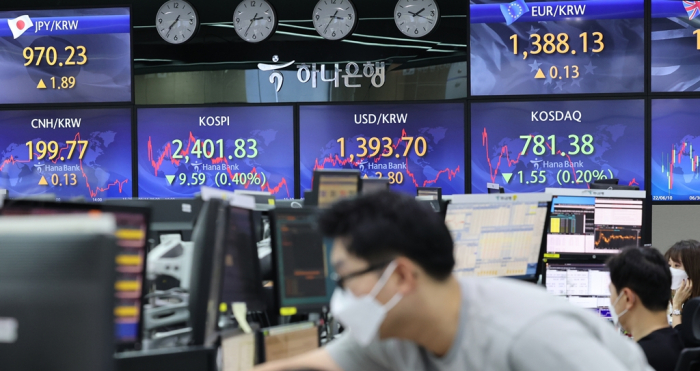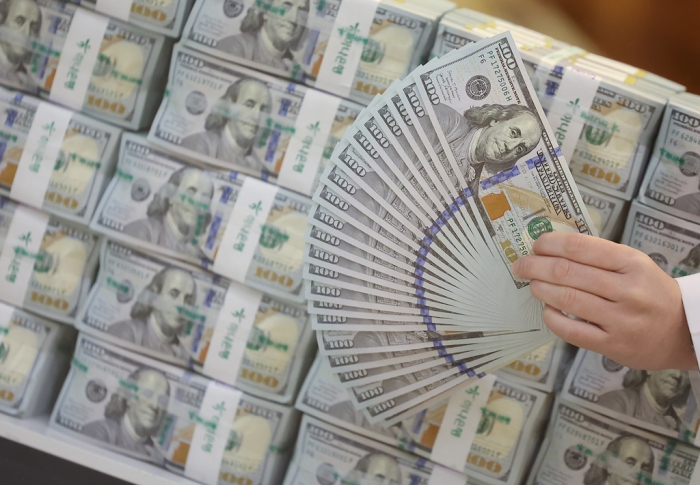Foreign exchange
S.Korea may have spent over $700 mn to support ailing won
The South Korean currency is expected to weaken past 1,400 per dollar in the near term, the next level will be 1,450 – analyst
By Sep 15, 2022 (Gmt+09:00)
3
Min read
Most Read
LG Chem to sell water filter business to Glenwood PE for $692 million


Kyobo Life poised to buy Japan’s SBI Group-owned savings bank


KT&G eyes overseas M&A after rejecting activist fund's offer


StockX in merger talks with Naver’s online reseller Kream


Mirae Asset to be named Korea Post’s core real estate fund operator



South Korea was estimated to have dumped more than $700 million on Thursday to support the ailing won currency as it risked breaking through the psychologically important 1,400 per dollar level, traders said.
The foreign exchange authorities also warned of measures to prevent the local unit from depreciating further as a softer won could exacerbate inflationary pressure in Asia’s fourth-largest economy.
The won lost as much as 0.5% to hit 1,397.9 against the dollar, its weakest since March 31, 2009, around 1:10 pm local time.
Ten minutes after the South Korean currency neared the 1,400 level, a foreign exchange official issued a warning.
“We are closely monitoring potential herd behavior in the market when recent external factors increase the won’s volatility,” said the official, adding they will take action as necessary.
After the comment, the authorities were suspected of pouring in dollars to support the worst performer among emerging Asian currencies with a 14.7% depreciation versus the greenback so far this year.
TRADING VOLUME MORE THAN DOUBLES ON INTERVENTION
Currency traders estimated the authorities dumped more than $700 million into the market, given the jump in trading volume. The dollar/won spot trading volume totaled $554 million from 12:30 p.m. to 1 p.m,. but the volume surged to $1.4 billion in the following 30 minutes. The total spot trading volume in the domestic currency market reached $8.7 billion.
The intervention helped the won recover some of its losses to trade at around 1,391 before ending the local market down 0.2% at 1,393.7.
“The size of intervention was not that big compared with those of the global financial crisis when they spent $4 billion-$5 billion a day,” said a market participant. “They seemed to slow the won’s weakness, rather than to defend the 1,400 level.”
Another official from the authorities, however, declined to comment on the intervention.

CONTINUOUS WARNING
Finance Minister Choo Kyung-ho made a stronger-than-usual warning, saying “we cannot just let it go.”
“We will take necessary steps including market stabilization measures at necessary times if there is excessive herd behavior or uncertainties spread,” Choo told lawmakers.
President Yoon Suk-yeol also told Bank of Korea Governor Rhee Chang-yong, Financial Services Commission Chairman Kim Joo-hyun and Financial Supervisory Service Governor Lee Bok-hyun to prepare measures to stabilize financial markets.
“As inflation is expected to remain high for a considerable period and major central banks are predicted to raise interest rates, please check major economic indicators and market conditions in a pre-emptive manner,” Yoon said in a lunch meeting.
Such warnings, along with actual intervention, indicated the authorities may try to keep the won stronger than 1,400 per dollar for the time being, analysts said.
“Sentiment is important for an economy, so the authorities could not help defending the 1,400 level,” said Moon Hong-cheol, an economist at DB Financial Investment.
The Bank of Japan was also suspected of preventing the yen from weakening past the 145 per dollar level, traders said.
BREAKING 1,400 PER DOLLAR JUST A MATTER OF TIME
The won, however, is likely to break through the 1,400 level in the near term as it has few bullish factors, analysts said.
South Korea’s exports are expected to slow as its largest overseas market Chinese economy is weakening on fresh lockdowns on a resurgence in COVID-19 and the sluggish property sector. Sales of semiconductors, South Korea’s key export item, are also losing steam.
The US Federal Reserve is predicted to aggressively raise interest rates to stem rampant inflation in the world’s largest economy. Some investors even bet on a full percentage-point interest rate hike at the policy meeting Sept. 20-21, although the majority expected a 75-basis-point move.
The risk of an economic recession in Europe is growing as Russia has shut down its main westward gas pipeline indefinitely.
“It is inevitable for the won to weaken further by year-end,” said Baek Seok-hyun, a currency analyst at Shinhan Bank. “Once it breaches the 1,400 level, the next level will be 1,450.”
Write to Mi-Hyun Jo and Dong-Woo Jwa at mwise@hankyung.com
Jongwoo Cheon edited this article.
More to Read
-

-
 EconomyKorea inflation slows, but BOK may still hike interest rates
EconomyKorea inflation slows, but BOK may still hike interest ratesSep 02, 2022 (Gmt+09:00)
2 Min read -
 Central bankBOK delivers fourth straight rate hike as inflation persists
Central bankBOK delivers fourth straight rate hike as inflation persistsAug 25, 2022 (Gmt+09:00)
3 Min read
Comment 0
LOG IN


